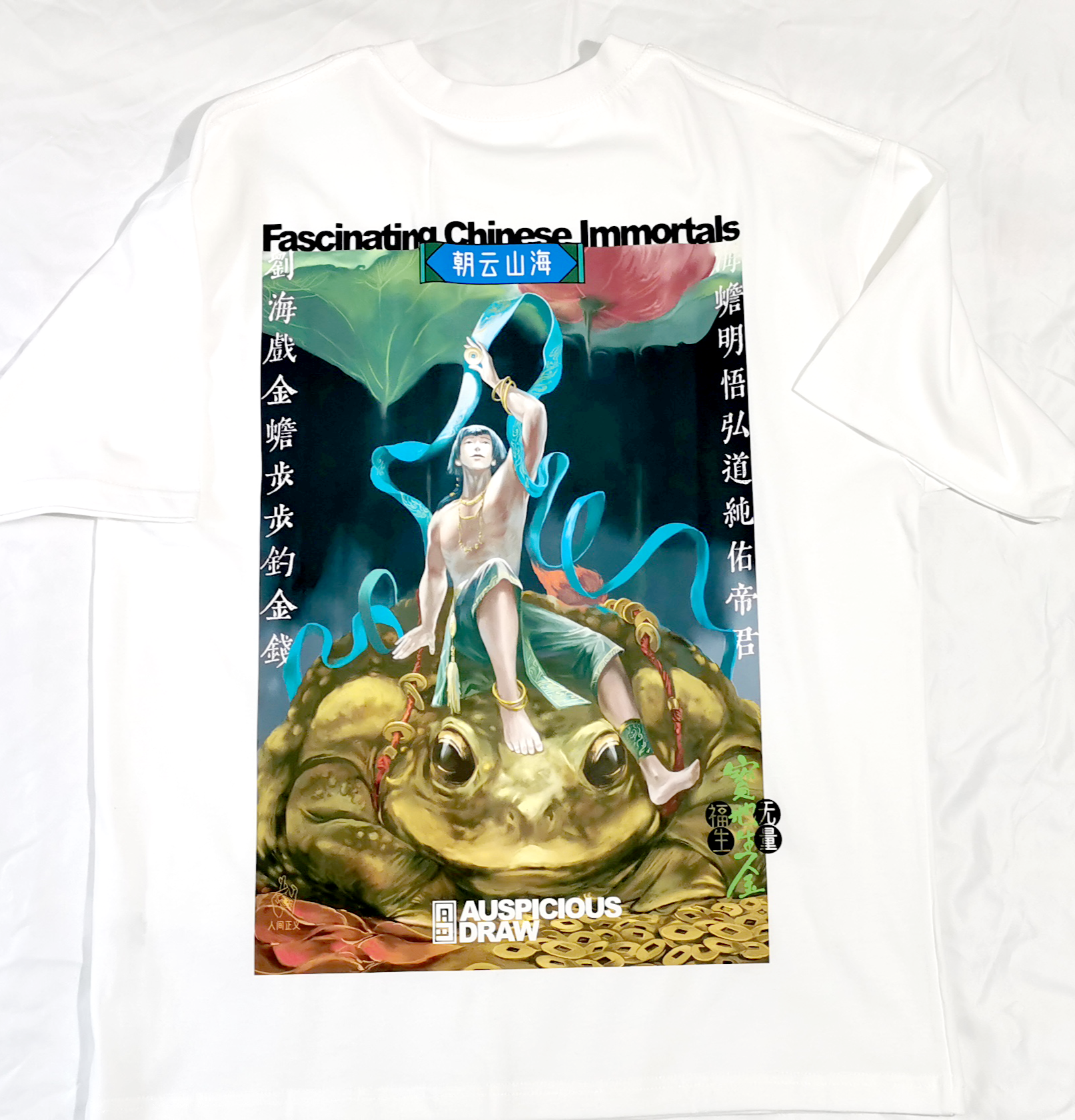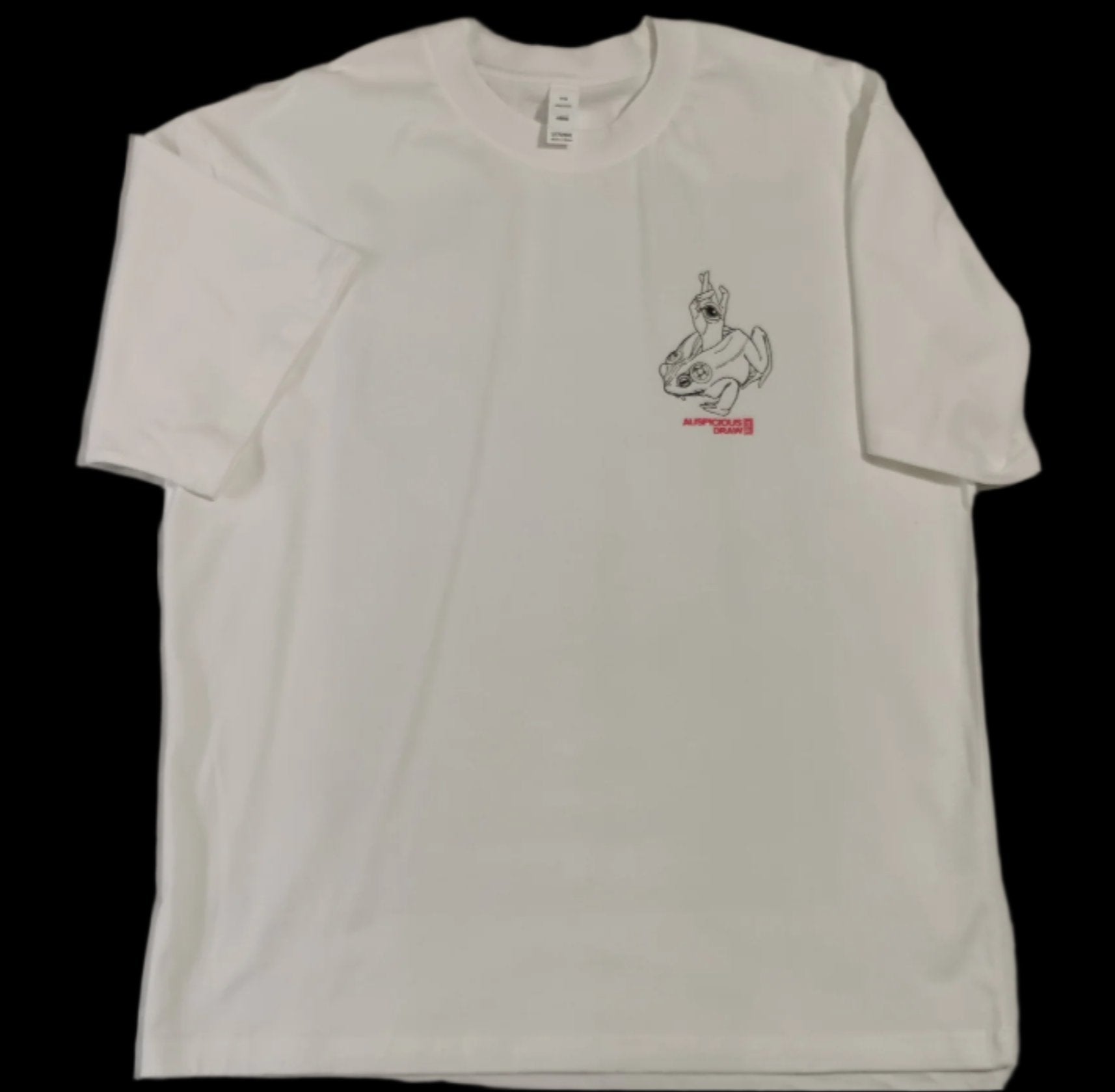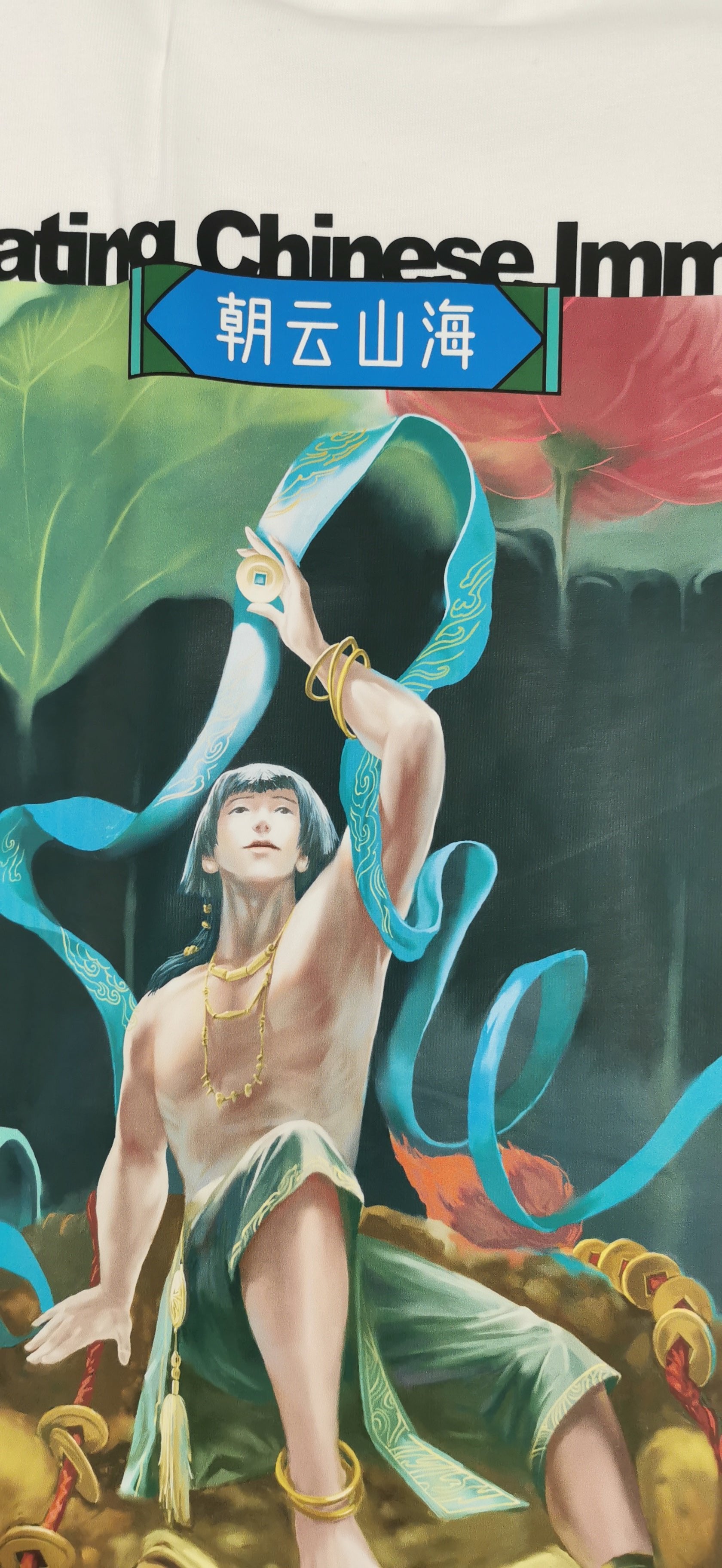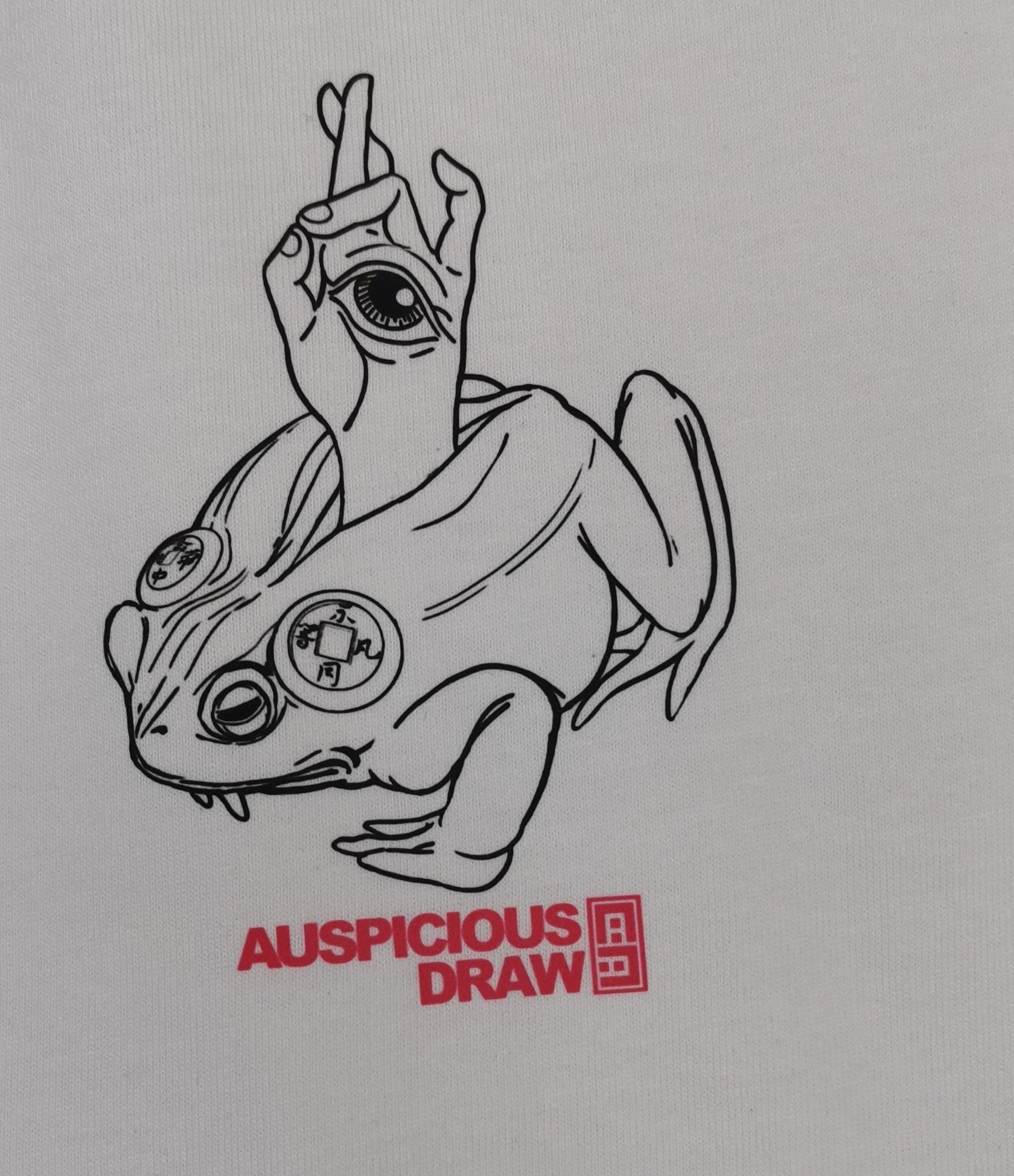



”Frog God” Liuhaichan shot sleeve T-shirt
Since Liu Haichan supposedly lived in the Guangyang District of Langfang, Hebei, he is also called Guangyang Xiansheng 廣陽先生 "Sir Guangyang" and Guangyang Liu Zhenren 廣陽劉真人 "Liu the Perfected Person from Guangyang".
The immortal Liu Hai is usually depicted as a young man with bangs, and his eponym liúhǎi 劉海 means "bangs; fringe" in Modern Standard Chinese.
In Chinese biological classification, the name hǎi chánchú 海蟾蜍 (lit. "sea toad") designates the toad species Bufo marinus (which is not native to China), while hǎi chányú 海蟾魚 (lit. "sea toad fish") designates the genus Thalassophryne of the toadfish family Batrachoididae (Greek θαλασσα thalassa "sea" + φρυνε phryne "toad") - likewise not native to China. Certain species of subfamily Batrachoidinae of the Batrachoididae, on the other hand, are native to Southeast Asian waters and, with their toad-like appearance (featuring a bloated thorax narrowing abruptly to a slender tail) bear a distinct similarity to the traditional jīnchán: the thin tail of the toadfish, with its attendant tail fin resembles the curious third leg (with its attendant webbed foot) of the jīnchán .
The English common name sea toad, by contrast, is a catch-all for the deep-sea anglerfish family Chaunacidae.
In the Japanese language, Ryū Kaisen 劉海蟾 is also called Gama Sennin 蝦蟇仙人 "Toad Immortal" and his three-legged toad companion is identified as Seiajin 青蛙神 "Frog God". Chinese Qīngwā Shén 青蛙神 The Frog God is a short story by Pu Songling collected in the (1740) Strange Tales from a Chinese Studio
The sinologist Henri Doré says there is no agreement as to Liu Haichan's name, much less as to his acts and deeds.
The hagiographic data on Liu Haichan are scant. His name is rarely mentioned, even in records about his putative beneficiary Zhang Boduan, except for one statement that Liu conveyed jīndān 金丹 "pill of immortality" formulas to Zhang during his visit to the region of Shu in 1069.
Liu Haichan is first recorded in several collections of biji "miscellaneous notes; notebooks" as a disciple of Chen Tuan (d. 989). Later hagiography is only found in compilations of the Quanzhen School, which claimed him as a patriarch.
The earliest biography of Liu Haichan is in the (1241) Jinlian zhengzong ji 金蓮正宗記 "Records of the Orthodox Sect of the Golden Lotus", which inspired most later accounts of his life. It records that Liu was a native of the Yan Mountains, a major mountain range in northern Hebei province, near present-day Beijing. During the turbulent Five Dynasties period (907-957), Liu, who was an expert in Huang-Lao philosophy, passed the imperial examination with a jinshi degree. After briefly serving as a minister to Liu Shouguang, the self-declared emperor of the Yan state (911-914), Liu Haichan was appointed prime minister under Abaoji in 916, the founder of the foreign Liao dynasty or Khitan Empire (907-1125).
There is a famous story about how Liu Haichan was converted to Daoism. One day, at the height of his glory, Liu met a Daoist monk who called himself Zheng Yangzi 正陽子 "Master of Correct Yang"—but was actually the renowned Immortal Zhongli Quan. He asked Liu to get ten eggs and ten gold cash coins (with a hole in the middle), and then placed a coin under each, and piled them one on top of another. Liu yelled "How dangerous!" and the Daoist smilingly replied, "The position of a prime minister is much more dangerous!". Liu was suddenly awakened, resigned from his position, gave up his wealth, left home, and went wandering. He changed his name to Liu Xuanying and the Daoists called him Haichan "Sea Toad". Liu lived alone and practiced self-cultivation while travelling in Shaanxi between Mount Hua, a famous location for Daoist and Buddhist monks, and the Zhongnan Mountains, until he achieved Daoist xian-hood "immortality; transcendence".
As an immortal, Liu Haichan was especially revered in the 12th and 13th centuries. Quanzhen accounts said he was a friend of the Daoist adepts Chen Tuan (d. 989), Zhong Fang 種放 (955-1015), and Zhang Wumeng 張無夢 (fl. 985-1065). Liu was much less famous than his disciple Zhang Boduan 張伯端 (d. 1082), the author of the Wuzhen pian.[
Liu Haichan's teachers were two of the Eight Immortals, Zhongli Quan (aka Zheng Yangzi above) and Lü Dongbin. These three were famous for roaming the world and persuading people to search for Daoist immortality. Their encounters were favorite topics not only of hagiographic works, but also of poems and plays. Although Zhongli and Lü have enjoyed a more durable popularity, Liu plays an eminent role in a number of stories. For example, the semi-vernacular Ningyang Dong zhenren yuxian ji 凝陽董真人遇仙記 "Records of the Perfected Person Dong Ningyang's Encounters with Immortals", which tells the tale of a Jurchen soldier, Dong Shouzhi 董守志 (1160-1227), who repeatedly received visits and instructions from Liu, Lü, and Zhongli, and started a new Daoist school.
Scholars are uncertain about the dates of Liu Haichan's life, and have said he lived in the 10th century, Five Dynasties Period (907-960), floruit 1031,. and died before or circa 1050. Holmes Welch notes the chronological problem with Liu Haichan's hagiography. If he was a disciple of Lü Dongbin (fl. c. 800), a minister to Liu Shouguang in 911-913, and the teacher of Zhang Boduan in 1070, Liu Haichan "must have lived some 270 years, a ripe old age even among Taoists". Welch concludes that a disciple could adopt a Daoist master posthumously, either through books or visions.
Liu Hai employed [his toad] as a charger to carry him instantaneously from place to place. The creature was not entirely reconciled to this mode of life, and occasionally escaped by diving down the nearest well. Its passion for the gleam of gold, however, invariably led to its recapture, when its master dangled a string of cash before its eyes. He is popularly represented with one foot on the toad's head, holding in his hand a ribbon, or fillet, on which are strung five golden coins. The design is known as "Liu Hai sporting with the toad" (劉海戲蟾), and is regarded as highly auspicious and conducive to good fortune. Another version of the story, inconsistent with the last or the Moon theory, is that the reptile lived in a deep pool and exuded a vapour poisonous to the neighborhood, and that it was thus hooked and destroyed by Liu Hai, exemplifying the fatal attraction of money to lure men to their ruin.

